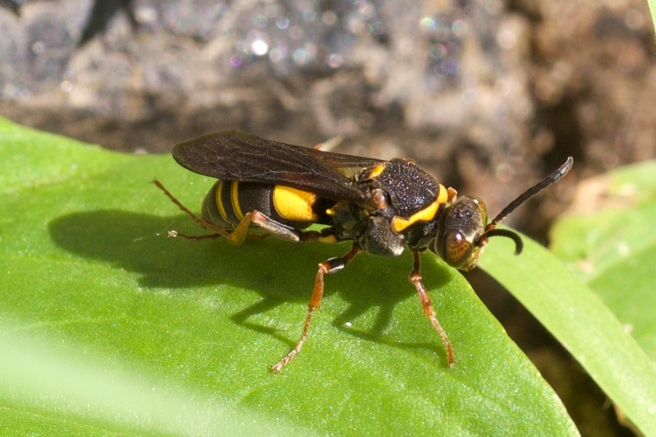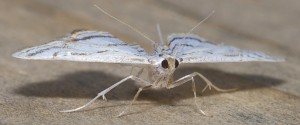
Obviously, the laws of the universe are such that the day after one finishes a guidebook to the wasps and bees the author will step outside and immediately see a species that is new and not included in the book. Actually, make that seven new species. In the weeks following the printing of the first edition of A Photographic Guide to Some Common Wasps and Bees of Minnesota, I’ve encountered seven species I hadn’t photographed before in the state. While I expected this would happen, I’m a little surprised at the abundance of previously overlooked species. But it’s a good thing. And I plan to add information here at Of Books and Bugs on these additional species. The first species (discussed below) probably doesn’t qualify as a “common” species.
Scientific name: Nysson plagiatus Cresson, 1882
Common name: Devious Sand Wasp (proposed)
Family: Crabronidae
This wasp showed up, a little conspicuously, among a densely congregated nesting site of Great Golden Digger Wasps (Sphex ichneumoneus). At first it stood at the entrance to one of the nests, then (as I leaned in for a closer look) this black and yellow wasp flew a few inches away to a leaf and proceeded to groom itself. In the moments that followed, several of the large sphex wasps arrived with prey, katydid nymphs, long and slender and pallid after being envenomed. Each paralyzed katydid is left unguarded for a brief period of time at the lip of their burrow while sphex disappears below to prepare the cell. She reappears a few seconds later, takes hold of the katydid antennae, and whisks the katydid below ground. I wonder, if Nysson plagiatus is quick enough, devious enough, might it not be able to secret an egg on the katydid during the brief interval that sphex spends underground?
While Nysson plagiatus hasn’t been confirmed as a brood parasite of the Great Golden Digger Wasps (this would require rearing one from the contents of one of the nests), the circumstantial evidence seems to be mounting. Most of the Nysson species are brood parasites of closely related wasps within their same family, the Crabronidae, so it’s a bit of a mystery why or how this wasp came to be a brood parasite of a wasp from an unrelated family, the Sphecidae. It’s thought that the jump was facilitated by the Orthoptera prey certain Crabronid hunting wasps have in common with this Sphecid hunting wasp.
Formerly placed in genus Synnevrus but recently moved to Nysson, its taxonomical status may not be settled. The yellow marking the full width of the first abdominal segment, differentiates Nysson plagiatus from Nysson aequalis which has a yellow marking only about half as wide.



Beautiful pictures! Do these wasps travel across states or are they generally local? I’m wondering how many in your book would be spending time at the Jersey Shore 😉 I see many types of wasps and flies in my yard but have no clue what they are. Good luck with the book!!
Thanks for the comment. Almost all the species included in my book, and the ones that I’m still discovering, are eastern species and can be found in New Jersey as well as Minnesota. The only truly western species included is the Pollen Wasp (Pseudomasaris vespoides), and that photo’s from the Badlands in South Dakota and included as a hypothetical for a couple drier sites in western Minnesota. There are so many solitary bee species, that I would suspect that the most common species in New Jersey will differ from the common species here, but again there’s probably a fair amount of overlap. One of the most useful guidebooks that I own is Insects of New England and New York by Tom Murray. No matter what, I predict you’ll get a lot of enjoyment out of determining which wasps and flies are visiting your yard.